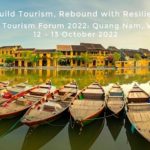 1. What are your targets for Viet Nam tourism in 2022?
1. What are your targets for Viet Nam tourism in 2022?
In the last “normal” year, 2019, we attracted over 18 million foreign visitors. China, South Korea, Japan are traditionally our biggest markets. We have the ambitious target of attracting five million foreign tourists in 2022, up from almost zero in 2021, which was due to Covid-19. In the first eight months of 2022, we welcomed over 1.2 million international tourists. Besides the international market, Viet Nam’s tourism industry aim was to serve 60 million domestic tourists by the end of 2022. However, the number of domestic visitors has already exceeded the target, reaching 79.8 million visitors. Domestic tourism is forecast to fully recover in 2022.
2. Is there a new emphasis or focus in Viet Nam’s 2022-23 tourism promotion campaigns?
We completely re-opened the door for tourism from 15 March, 2022. Viet Nam is one of very few countries in the Asia-Pacific region opening to international tourism without any entry conditions required. We promote communication to attract international tourists to Viet Nam with the campaign “Live fully in Viet Nam”. The Viet Nam tourism marketing plan 2022 – 2023 is to bring an image of a safe, friendly and hospitable Viet Nam to the world. We are focussing on smart and sustainable tourism development followed by green and responsible travel.
3. What role does Quang Nam province play in Viet Nam’s tourism marketing plans?
It plays an increasingly important role as part of our tourism cluster strategy. Quang Nam together with Da Nang, Thua Thien Hue will be one of the clusters in Central Viet Nam. The national tourism year 2022 was chosen to be held in Quang Nam with the theme of ‘green destination’ because of its potential. It is already known as a visitor-friendly destination thanks to its natural resources and wonderful coastline. It offers a vibrant culinary scene, many cultural attractions, and a diverse history, especialy Hoi An ancient town. For tourists seeking a sustainable travel experience where you can learn as well as appreciate nature, Quang Nam is home to productive farms, handicraft villages, rivers, mountains, and unspoiled natural attractions.
4. Which new tourism-related infrastructure projects will improve the tourism sector in Viet Nam?
We have a lot going on, much of it guided by the Viet Nam Tourism Development Strategy to 2030. The strategy clearly defines our goal in developing modern and holistic infrastructure, especially transport infrastructure in tourism clusters, national tourist sites and areas with tourism potential. We are taking an inclusive approach to tourism infrastructure development, which focuses not only on international-class tourism destinations, such as Hoi An, Sapa, Ha Long, Da Nang, Nha Trang and Phu Quoc, but also on secondary tourism destinations, especially ones with potential to connect to regional tourism networks. Regarding Greater Mekong Subregion cooperation, for the last 20 years, Viet Nam has participated in four regional tourism infrastructure development projects sponsored by the Asian Development Bank, among which the latest is the Second GMS Tourism Infrastructure for Inclusive Growth Project. These projects were designed to improve the accessibility to secondary tourism destinations in provinces along GMS economic corridors as well as to enhance the environmnental conditions and urban infrastructure for tourism development.
5. What does Viet Nam Tourism hope will be the positive outcomes from the 2022 Mekong Tourism Forum?
There are three outcomes we would like. First, to strengthen linkages between the leaders of the sub-region’s tourism industry, with the aim of rapidly recovering the tourism industry in a sustainable, resilient and comprehensive way, to promote the sub-region’s tourism as a common destination. Second, to introduce the city of Hoi An, voted as one of the 25 best cities in the world; also, to introduce Quang Nam in Central Viet Nam as an ideal destination for green and sustainable tourism, rich in cultural values, full of amenities of a top-class beach resort. Third, the Forum demonstrates the recovery of the tourism industry, the return of sellers and buyers in the region, after a period of travel freeze. Our aim is to promote a rapid recovery of international tourism and create sustainable tourism supply and demand.
6. What message do you have for tourism leaders and delegates attending the Forum?
We should focus on practical goals that make the travel and tourism industry better for the benefit of our populations. My message is, “Let’s act together for sustainable tourism growth.” I hope all delegates arrive in a positive state of mind to listen, learn and return home motivated to “Rebuild Tourism, Rebound with Resilience” – the theme of the 2022 Mekong Tourism Forum.















